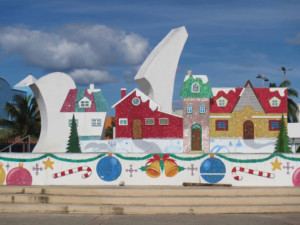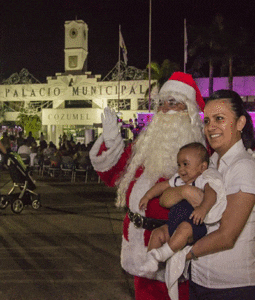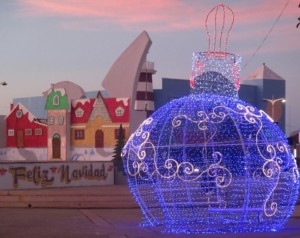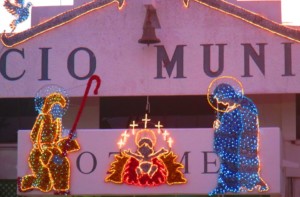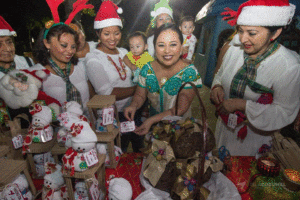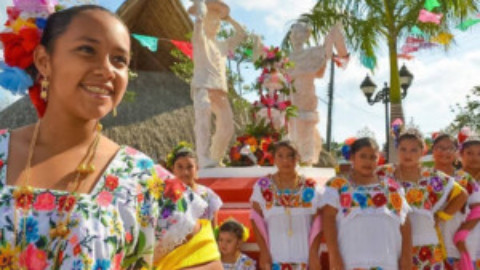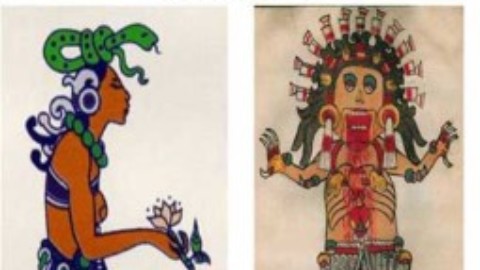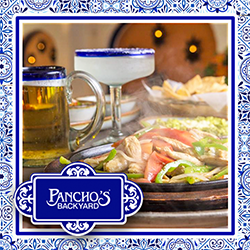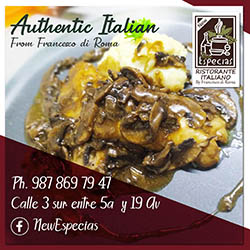Christmas in Mexico
Monica Sauza shares Mexican history & traditions regarding Christmas….
The celebration of Christmas in Mexico goes back to Colonial times and the influence of Catholicism. In their quest to teach the new religion to the indigenous peoples, the Spanish missionaries made use of the existing traditions. During Winter Solstice (December 21) the Aztecs worshipped the birth Huitzilopochtli, of one of their two main deities, god of the sun and war.
After Huitzilopochtli had traveled through the celestial vault, he returned to Mictlán (the place for the dead) as a hummingbird. These celebrations began early December in all homes; guests were invited over to share food, “alegrías” (amaranth candy), and given presents of small idols made of corn and honey. The sun was reborn on December 24, and the rebirth was celebrated with rituals and dances.
The transition into the catholic religion did not take long, as only a few years after the arrival of the Spaniards, Joseph’s and Virgin Mary’s pilgrimage to Bethlehem seeking shelter for the birth of Baby Jesus was recreated and carols written and sung.
These representations gave origin to the Posadas, a unique Mexican tradition that, back then and still today, the Posadas take place from December 16 to the 24. Although initially consisting of processions in church courtyards while parishioners sang litanies and carried Joseph’s and Mary’s images, nowadays Posadas are typically celebrated along friends and family, still preserving the roots.
Friends and family split into two groups, each group sings different verses of a litany while one plays the part of Joseph and Mary asking for Posada (shelter) and the other, the part of the innkeepers, sometimes even knocking at neighbors’ homes. Following the representation, comes the piñata.
Imported from China, it was used by the friars as an instrument to teach the natives about the seven capital sins portrayed by the piñata’s peaks or spikes; every blow symbolized beating down the sins/evil. The reward was and is in the form of assorted candy, fruit and toys after the colorful piñata breaks. All this is followed by dinner and many times include the typical ponche, a warm fruit punch sometimes spiked with brandy or rum or tequila.
Many of you living in Cozumel may wonder about the children knocking at your doors in December, carrying peculiarly decorated branches and asking if they can sing La Rama (‘the branch’) for you. Another age-old custom from Colonial times originated in the State of Veracruz and expanded to the States of Tabasco, Chiapas, Yucatan and Quintana Roo.
With their ornamented branches, children sing for you -oftentimes off-key- expecting to receive a few coins at the end which will be used for their own Posada. Nowadays, most of these States hold contests for the most original Rama.
The Aztecs and Maya made dramatic performances of hunts, men dressed up as animals, etc. and the Spanish
missionaries made use of these histrionic skills to stage the Pastorelas as a means of evangelization. The word derives from the Italian pastorella, meaning shepherd girl.
The play-acting included Joseph and Mary’s pilgrimage and the humorous adventures of shepherds dodging obstacles to arrive on time for Baby Jesus’ birth.Pastorelas, illustrating the perennial fight between good and evil and a combination of divine and human characters, are still staged but have been modified; even if they still preserve their originality, they are a bit more sarcastic as, for instance one of the main characters, the devil, is compared with current politicians, ridiculed and defeated by other characters. In the end, the intention is to represent justice, miracles and promises of salvation which this season brings.
Among this season’s traditions in Mexican Catholic homes are the mangers, whether in small size or even life-size figurines, these portray the birth of Baby Jesus and the Holy Family; some are real works of art as they recreate villages, lakes, homes, a depiction of the everyday life in Bethlehem of the past.
Traditionally, the mangers remain until after January 6, the Three Kings Day/Epiphany although some until February 2, the Day of the Virgin of Candelaria.
After the Posadas, which end at 11:30 pm on December 24, comes Nochebuena or Noche Buena (literally the ‘Good Night’ – Christmas Eve). This is a very special time when families get together at home for the birth of Baby Jesus. Before dinner, while some attend midnight mass, at home after the bells toll 12 times, standing before the manger each member cradles Baby Jesus making a silent or audible petition and the Baby is finally placed for the first time, at home, in the crib at the manger. Then the hugs, good wishes, maybe a few presents and a scrumptious late dinner. One of the legacies from Mexico’s ancient culinary past is the guajolote (turkey), native of Mexico, included by the Spanish Conquistadors into their diet as a delicacy.
The Nochebuena dinner is a major event; a compilation of tastes and seasonings influenced by many cultures, still preserving Mexico’s original flavors, adapted to each region: the turkey, theromeritos (which resemble rosemary) served with patties of shrimp, potatoes in mole sauce; the bacalao (dried salted codfish) stewed with tomatoes, capers, olives, and potatoes; pozole, tamales, buñuelos (sweet fritters),ponche….and many other exquisite dishes and combinations!!For the Catholic Church December 25 is the day to remember Christ’s birth.
Time has passed, but the ancestral spirit lives on in a beautiful gift that Mexico gave the world, one of the most emblematic Christmas symbols: the poinsettias or Flor de Nochebuena (Christmas Eve Flower). Long before Christendom arrived to Mexico, the Aztecs cultivated the Cuetlaxochitl and was used by the missionaries to decorate mangers. Its name in English is in memory of Joel R. Poinsett, appointed the first American Minister to Mexico in 1825, who sent samples of the plant to the US.
On December 24, 1899 the Cuetlaxochitl first adorned the Vatican’s Saint Peter’s Basilica. World traditions and religions may be different, but no matter how you celebrate flow with this season’s magic, goodwill, hope, sharing, joy, peace and love and hold them in your hearts all year long.
Feliz Navidad!!!!
La Navidad en México por Monica Sauza
La Navidad en México se remonta a la época colonial y la influencia del catolicismo. En su cruzada por enseñar la
nueva religión a los indígenas, los misioneros españoles aprovecharon las tradiciones existentes. Durante el Solsticio de Invierno (Diciembre 21) los aztecas veneraban el nacimiento de Huitzilopochtli, una de sus dos deidades principales, dios del sol y de la guerra. Después de que Huitzilopochtli había atravesado la bóveda celeste, regresaba a Mictlán (el lugar de los muertos) en forma de colibrí.
Estas celebraciones se realizaban a comienzos del mes de Diciembre en todos los hogares. Los invitados compartían los alimentos, las alegrías (dulce de amaranto) y recibían regalos en forma de pequeños ídolos hechos de maíz y miel. El sol renacía el 24 de Diciembre, y el renacimiento se celebraba con rituales y danzas.
La transición a la religión católica no tardó demasiado ya que sólo unos años después de la llegada de los españoles, el peregrinaje de José y la Virgen María buscando posada para el nacimiento del niño Jesús fue representada y se escribieron y cantaron letanías. Estar representaciones dieron origen a las Posadas, una tradición única de México la cual, en aquel entonces y aún en la actualidad, se llevan a cabo del 16 al 24 de Diciembre.
A pesar de que inicialmente consistían de procesiones en atrios de las iglesias mientras los feligreses cantaban letanías y cargaban imágenes de José y María, en la actualidad las Posadas se celebran entre amigos y la familia, conservando aún las raíces. Los amigos y la familia se dividen en dos grupos, cada grupo canta distintos versos de una letanía en tanto uno representa la parte de José y María pidiendo Posada, y la otra hace la parte de los mesoneros, en ocasiones hasta tocando las puertas de los vecinos.
Después de la representación, viene la piñata. Importada de China, esta fue utilizada por los frailes como un instrumento para enseñar a los indígenas acerca de los siete pecados capitales, representados por los picos de la piñata. Cada golpe simbolizaba la derrota de los pecados/la maldad. La recompensa era y es en la forma de diversos dulces, fruta y juguetes después de romper la piñata. A todo esto sigue una cena y en muchas ocasiones se incluye el típico ponche, una bebida caliente a la que a veces se le agrega el “piquete” de brandy o ron o tequila.
Es posible que muchos de ustedes que viven en Cozumel les extrañe la presencia de niños que tocan a sus puertas en Diciembre, cargando ramas decoradas y preguntando si pueden cantarle La Rama.
Es otra antigua costumbre de la época colonial que se originó en el estado de Veracruz extendiéndose a Tabasco, Chiapas, Yucatán y Quintana Roo. Con sus ramas adornadas los niños cantan para ustedes, con frecuencia algo desentonados, esperando recibir unas monedas al final de su representación las cuales serán para sus propias Posadas. En la actualidad, la mayoría de estos estados tienen competencias de la Rama más original.
Los aztecas y los mayas realizaban representaciones dramáticas de cacerías, de hombres disfrazados de animales, etc., y los misioneros españoles aprovecharon estas habilidades histriónicas para escenificar las Pastorelas como medio de evangelización. La palabra deriva del italiano pastorella, que significa pastorcilla. La puesta en escena incluía el peregrinaje de José y María, y las graciosas aventuras de unos pastores capeando obstáculos para llegar a tiempo al nacimiento del Niño Jesús.
Las Pastorelas, que ilustran la perene lucha entre el bien y el mal y una combinación de personajes divinos y humanos, aún se presentan pero han sido modificadas. A pesar de que aún conservan su originalidad, son un poco más sarcásticas, pues, por ejemplo, uno de los personajes principales, el diablo, es comparado con políticos de la actualidad, ridiculizados y vencidos por los demás personajes. Al final, la intención es la de representar la justicia, los milagros y las promesas de salvación de esta época.
Entre las tradiciones de esta temporada en los hogares católicos mexicanos están los pesebres; ya sean de pequeñas figurillas o de tamaño natural, describen el nacimiento del Niño Jesús y la Sagrada Familia. Algunos son verdaderas obras de arte pues reproducen poblados, lagos, casas, una descripción de la vida diaria del Belén del pasado. Tradicionalmente, los pesebres se conservan hasta pasado el 6 de Enero, el día de Reyes/Epifanía aunque algunos no son retirados sino hasta después del 2 de Febrero, el día de la Virgen de la Candelaria.
Después de las posadas, las cuales concluyen a las 11:30 p.m. del día 24 de Diciembre, viene la Nochebuena o Noche Buena. Este es un momento muy especial cuando las familias se reúnen en casa para el nacimiento del Niño Jesús. Antes de la cena, en tanto que algunos van a misa, en casa después de las 12 campanadas frente al pesebre cada miembro de la familia arrulla al Niño Jesús haciendo una petición en silencio o en voz alta, y el Niño es finalmente colocado por primera vez, en casa, en su cuna en el pesebre. Luego vienen los abrazos, los buenos deseos, tal vez algunos regalos y una deliciosa cena ya entrada la madrugada.
Uno de los legados del antiguo pasado culinario de México es el guajolote (pavo); originario de México e incluido en la dieta de los conquistadores como manjar. La cena de Nochebuena es un gran evento. Una compilación de sabores y especias influida por muchas culturas, aún conservando los sabores originales mexicanos, adaptada según a cada región: el pavo, los romeritos (que se parecen al romero) servidos con tortitas de camarón, papas en salsa de mole; el bacalao guisado con tomates, alcaparras, aceitunas y papas; pozole, tamales, buñuelos, ponche… ¡y muchos otros exquisitos platillos y combinaciones! Para la iglesia Católica, el 25 de Diciembre es el día para recordar en nacimiento de Cristo.
El tiempo ha pasado, pero el espíritu ancestral vive en un bello regalo que México dio al mundo, uno de los símbolos más emblemáticos de la Navidad: la Flor de Nochebuena. Mucho antes que la cristiandad llegara a México, los aztecas cultivaban la Cuetlaxochitl y los misioneros la utilizaron para decorar los pesebres. Su nombre en inglés, poinsetta, es en memoria de Joel R. Poinsett, quien fuera designado el primer ministro estadounidense en México en el año 1825, y quien enviara muestras de la planta a los EUA. El 24 de Diciembre del año 1899 la Cuetlaxochitl adornó por primera ocasión la Basílica de San Pedro en el Vaticano.
Las tradiciones y religiones en el mundo pueden ser diferentes, pero no importa como celebre la Navidad, fluya con la magia, buena voluntad, esperanza, el compartir, la alegría, paz y amor de esta época, y consérvenlos en sus corazones durante todo el año.
¡Feliz Navidad!
- HammocksYucatan Monica Sauza - February 8, 2024
- Holidays Mexico 2024 - January 4, 2024
- Christmas Mexico Monica Sauza - December 21, 2023

